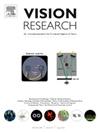Binocular summation of pupil light reflex with different light stimulation in each eye
IF 1.4
4区 心理学
Q4 NEUROSCIENCES
引用次数: 0
Abstract
Binocular summation of the pupil light reflex refers to the phenomenon where the pupillary constriction elicited by binocular light stimulation is greater than the expected response based on monocular stimulation. An increase in the total flux reaching the retina influences pupil constriction. Under binocular conditions, the combined light entering both eyes is greater than that under monocular conditions, which can affect the pupil’s response. However, previous research indicates that equal luminance presented either to one eye or distributed equally between the two eyes cannot adequately explain the effect of binocular summation. This study aimed to investigate how pupil constriction differs when the total illuminance stimulating the eyes remains constant, but the distribution of illuminance between the left and right eyes varies. Nine participants viewed a flickering target stimulus at 1 Hz. We compared the average pupillary constriction across various interocular illuminance ratios, including a monocular condition (only one eye exposed to the total illuminance) and binocular conditions where the total illuminance was divided unequally or equally between the two eyes. The results showed that when the total illuminance stimulating the eyes was constant, pupil constriction was significantly stronger as the illuminance distribution between the eyes approached equality (i.e., a ratio closer to one), with binocular conditions generally causing stronger average constriction than monocular conditions. Furthermore, analysis of the power spectrum density at 1 Hz revealed no significant difference between the tested illuminance conditions, suggesting that the phasic response was similar despite differences in tonic constriction.
不同光刺激下双眼瞳孔光反射的总和
瞳孔光反射的双眼总和是指双眼光刺激引起的瞳孔收缩大于单眼光刺激预期反应的现象。到达视网膜的总光通量增加会影响瞳孔收缩。双眼条件下,进入双眼的联合光线比单眼条件下要大,这会影响瞳孔的反应。然而,以往的研究表明,无论是在一只眼睛上呈现相同的亮度,还是在两只眼睛之间均匀分布的亮度,都不能充分解释双眼叠加的效果。本研究旨在探讨当刺激眼睛的总照度保持不变,但左右眼之间的照度分布不同时,瞳孔收缩的差异。九名参与者观看了1赫兹的闪烁目标刺激。我们比较了不同眼间照度比下的平均瞳孔收缩,包括单眼条件(只有一只眼睛暴露在总照度下)和双眼条件(总照度在两只眼睛之间均匀或不均匀分配)。结果表明:当总照度一定时,瞳孔收缩明显增强,两眼之间的照度分布趋于相等(即比值接近1),双眼条件下瞳孔收缩的平均程度一般强于单眼条件。此外,对1 Hz功率谱密度的分析显示,在不同的照明条件下,相位响应是相似的,尽管在张力收缩方面存在差异。
本文章由计算机程序翻译,如有差异,请以英文原文为准。
求助全文
约1分钟内获得全文
求助全文
来源期刊

Vision Research
医学-神经科学
CiteScore
3.70
自引率
16.70%
发文量
111
审稿时长
66 days
期刊介绍:
Vision Research is a journal devoted to the functional aspects of human, vertebrate and invertebrate vision and publishes experimental and observational studies, reviews, and theoretical and computational analyses. Vision Research also publishes clinical studies relevant to normal visual function and basic research relevant to visual dysfunction or its clinical investigation. Functional aspects of vision is interpreted broadly, ranging from molecular and cellular function to perception and behavior. Detailed descriptions are encouraged but enough introductory background should be included for non-specialists. Theoretical and computational papers should give a sense of order to the facts or point to new verifiable observations. Papers dealing with questions in the history of vision science should stress the development of ideas in the field.
 求助内容:
求助内容: 应助结果提醒方式:
应助结果提醒方式:


